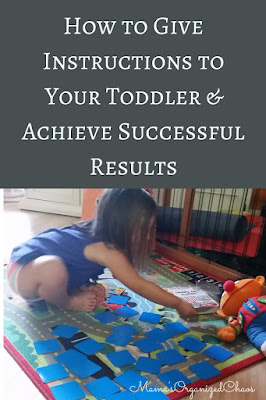It’s Babywise Friendly Blog Network week! See below for our full schedule this week (8 AMAZING posts on Babywise series topics that are not schedule or sleep related). Today is my post on “How to Give Instructions to Your Toddler & Achieve Successful Results”…
It may be of surprise to many, but the Babywise theory by Gary Ezzo, is actually so much more than schedules and sleep recommendations. Not only that, the Babywise series has recommendations that extend into the teenage years! I haven’t personally read the the older books yet, but I’ve read Babywise, Babywise II, PreToddlerwise, Toddlerwise, Preschoolwise, and Childwise. I am always amazed to see all that is packed into these books. From discipline to potty training, mealtime recommendations to family dynamics- the books really cover so much!
I always find it interesting to see how well our parenting style really fits in with many aspects of these books. We’ll come up with something to incorporate into our parenting, and then I’ll re-read one of these books for more ideas, only to find that many of our favorite ideas are also recommendations in these books. I then read the section again, and find even more ways to expand on the idea that we’ve been incorporating already. Just goes to show that Babywise is a great fit for my family!
One of our favorite techniques with our daughter, is something we use when asking her to do something or giving instructions.
We require two things:
1. “Look at Mama/Daddy, please” – Before we give Caroline any instructions, we make sure she is listening. This is something that I learned as a teacher (high school teacher no less). It doesn’t matter your age, if you aren’t looking, you most likely truly aren’t listening. So, we have Caroline look at us prior to giving any instructions or requests.
2. “Yes, Mama/Daddy” – Once we’ve given Caroline our request, we require a response. This helps in two ways. One, her acknowledgement of us tells us she heard us. Two, children are much less likely to throw a fit/tantrum if they are having to speak and give a response. We even give Caroline a heads up and say something like “Caroline it’s almost time to stop playing and go brush your teeth. When I come back in and ask you to come brush your teeth, I expect you to say ‘yes, Mama’“. Now she’s so accustomed to this I can end the above statement with a question- “…what should you say to Mama when I return?” She answers that she is to say “Yes, Mama”, and she is much better prepared mentally for this event to happen.
In the book Toddlerwise, Ezzo actually incorporates these ideas as well, in his principles of instruction recommendations (pages 94-96). “Following these basic guidelines can prevent stress and increase voluntary compliance. Failure to embrace them will lead to unwelcomed power struggles and battles of the will”. Boy have we found this statement to be true. These 4 principles have made a HUGE difference in how Caroline reacts and responds to instruction, and we strive to incorporate all 4 at all times.
4 Principles of Instruction (for Toddlers)
Principle One: Expect a Response
This is our incorporation of “Yes, Mama/Daddy”, and it works so well!
Ezzo also keeps it real, by stating that yes we should have high expectations, but we also need to be realistic that we are working towards a goal of 100% compliance with our children. If we aren’t honest with ourselves on goals versus reality, frustration levels can rise. I always find this helpful to hear again. Our children are very capable, but that capability changes with age and experience.
“Obedience for this age-group [2 year olds] means that a child complies with your instructions at least sixty percent of the time. Do not misunderstand this point, we are not saying sixty percent compliance is acceptable but rather you are working toward a total compliance sixty percent of the time. This figure changes as the child grows. By the time he reaches three it should jump to seventy percent. By age five it should be at eighty-five to ninety percent compliance.” (Toddlerwise, page 94)
Principle Two: Give Instructions, Not Suggestions
This is one that I really appreciated the reminder on. We are the parents, and we make the decisions. If it’s bedtime, say it’s bedtime. Don’t ask if your child is ready for bed. If it’s time to clean up, say it’s time and expect compliance and a response (principle one).
Principle Three: Healthy Discipline is Always Consistent
“When you draw the line, stay with it. The child brought back on course consistently is far better adjusted than the child whose discipline is inconsistent or incomplete. Consistency provides security and freedom”. (Toddlerwise, page 95)
I couldn’t agree with this more. From my teaching experience, and now with parenting experience, children do FAR better with high expectations and clear, consistent discipline/consequences, than they will if there is low expectations and/or any inconsistencies with consequences. This is hard though. Hard for the parent. You have to find what works for you and your child. It’s ok to say you were wrong and try something new next time. Just because you’ve tried one consequence doesn’t mean you are stuck with it. But don’t make threats. Only make statements you are willing to act upon, and then follow through.
Principle Four: Require Eye Contact
This is again one of our favorites that we mentioned above. When I forget to do this, Caroline does not listen as well. Then I realize that I forgot to have her make eye contact and really engage with me. I can’t enforce consequences fairly, if I don’t know if she was listening at all. So, eye contact it is. I simply say “Caroline, look at Mama please”. I do not give instruction until she does so. When she was young, this sometimes meant physically moving her to look at me so she learned what it meant and what my expectation was. Now that she’s older, if she does not make eye contact I repeat one time, and then remove whatever is distracting her.
“Here is something you can begin beetween twelve and fourteen months. This will help your child focus on your instructions and help him better process each instruction. Initially it could involve gently taking your child’s face in your hand and directing it toward you…” (Toddlerwise, page 96)
Other Posts of Interest
What is Babywise?
Babywise or Coincidence? (Our Success Story)
Babywise Isn’t Imposing a Schedule, It’s Learning the Ideal Schedule for YOUR Child
Babywise Myths (All BFBN Week Posts)
Please Deviate From Schedule, & Enjoy The Moments! (4th of July)
Benefits and Types of Routines – And How You Can Use Routines Without Using Schedules
5 Crucial Lessons To Teach Your Child That You Should Start Now
Promoting Positive Behavior by Offering Choices to Your Toddler
I am so excited for this week. All week the amazing ladies of the Babywise Friendly Blog Network are discussing topics from the Babywise series that are NOT related to schedules or sleep. I know, I know.. what!?!? Babywise has topics not related to schedules or sleep!? YES! And so many amazing ones at that! Check out the amazing line up we have for this week:
(All links will go live the day of)
- Monday – Valerie – How to Correct Your Preteen
- Monday- Natasha – How to Solve the “Wise in Their Own Eyes” Problem
- Tuesday – Kimberly – Intentional Parenting: How Our Beliefs and Goals Shape Our Parenting Decisions
- Tuesday – Caitlin – 5 Ways to Teach Children Kindness
- Wednesday – Katrina – How to Give Instructions to Your Toddler & Achieve Successful Results
- Thursday – Cole – Self Control is a Base Virtue
- Thursday – Carrie – Temper Tantrums & The Happy Heart Rug
- Friday – Emily – How to Teach Your Children Self Control
 |
| Click here to join the MOC Village |
?Don’t forget to leave a comment below! I love hearing from readers! Tell me what you thought of the post, share your experiences, and even drop a topic idea down for me!






